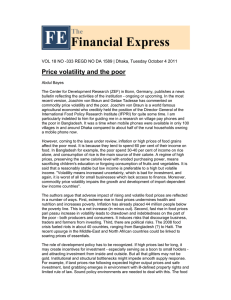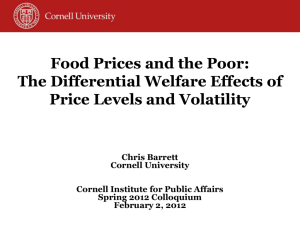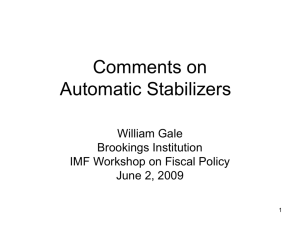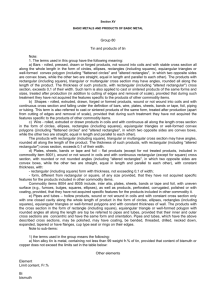The Grain Chain: Managing Wheat Imports in Arab
advertisement
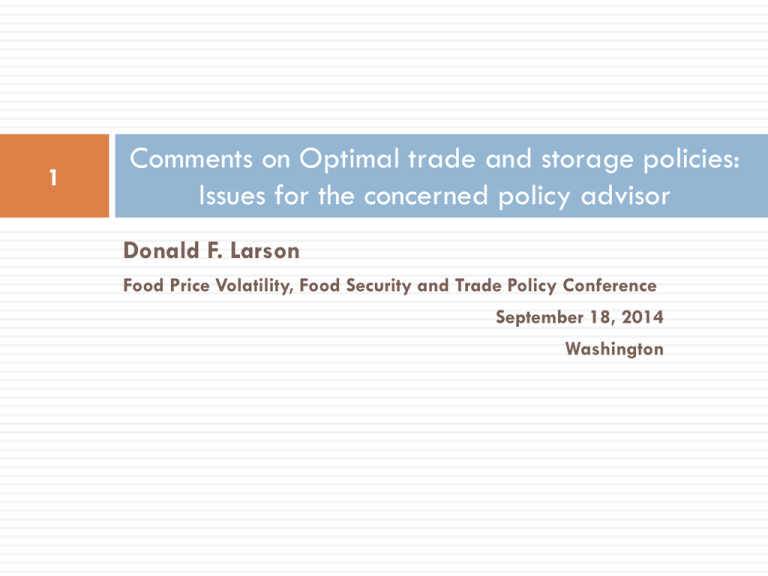
1 Comments on Optimal trade and storage policies: Issues for the concerned policy advisor Donald F. Larson Food Price Volatility, Food Security and Trade Policy Conference September 18, 2014 Washington Disclosure: Big Fan 2 Long history, but short list of practitioners Gustafson, Robert L. 1958. “Implications of Recent Research on Optimal Storage Rules.” Journal of Farm Economics 40(2): 290–300. Gardner, Bruce L. 1979. Optimal Stockpiling of Grain. Lexington, Massachusetts: Lexington Books. Wright, Brian D., and Jeffrey C. Williams. 1982. “The Economic Role of Commodity Storage.” The Economic Journal 92 (367): 596–614. Miranda, Mario J., and Joseph W. Glauber. 1995. “Solving Stochastic Models of Competitive Storage and Trade by Chebychev Collocation Methods.” Agricultural and Resource Economics Review 24 (1): 70–77. Makki, Shiva S., Luther G. Tweeten, and Mario J. Miranda. 1996. “Wheat Storage and Trade in an Efficient Global Market.” American Journal of Agricultural Economics 78 (4): 879–890. Wright, Brian D., and Carlo Cafiero. 2011. “Grain reserves and food security in the Middle East and North Africa.” Food Security 3 (Supplement 1): 61–76. Larson, Donald F. , Julian Lampietti, Christophe Gouel, Carlo Cafiero, and John Roberts. 2014. “Food security and storage in the Middle East and North Africa.” World Bank Economic Review 28(1), 48-73. How significant are the benefits? 3 Keep in mind that strategic storage and trade-based interventions are non targeted, so welfare benefits sum over a variety of individual/group effects Think of w as U’’ is related to risk aversion Price Food budget Wealth Generate welfare gain by reducing 𝑒 2 Staying in the world of non-targeted instruments, there is an addition to w that compensates volatility loss There is a level of consumer protection that on average compensates for volatile prices Utility based evaluation a la Newberry and Stiglitz (1981) Taylor expansion 1 2 𝑈 𝑤 + 𝑒 ≅ 𝑈 𝑤 + 𝑈′′ (𝑒 2 ) Utility = Level - volatility effect What is the right price to stabilize around? What triggers stabilization instruments? Is an index value of 140 high? 4 Judgment based on 2005-2009 Judgment based on 2007-2012 200 250 180 200 WB Food price index, 1995=100 WB food price index, 1995=100 160 140 120 100 80 60 40 150 100 50 20 0 Jan-04 May-05 Oct-06 Feb-08 Jul-09 Nov-10 0 May-05 Oct-06 Feb-08 Jul-09 Nov-10 Apr-12 Aug-13 Model can formalize a solution to the right price problem, but a validated model should replicate a sensible distribution Conversely, the validity of the model is anchored to the implicit price distribution it generates as a baseline 5 Three nominal price distributions from consecutive 20 periods 1960-1979 1980-1999 200 0 50 2000-2014 .05 .06 150 0 .02 .04 100 Density 0 50 2000-2014 0 Density .02 .04 .05 1980-1999 .06 1960-1979 Three US CPI distributions 50 100 150 200 50 100 agriculture Graphs by decades 150 200 cpi Graphs by decades 100 150 200 Exchange rates matter too 6 IMF’s real exchange rate index for India 1960-1979 0 0 .02 .04 .06 2000-2014 0 Density .02 .04 .06 1980-1999 0 50 100 150 200 rupees Graphs by decades 50 100 150 200 More problems… 7 Limitation of resources Political economy Sooner or later a string of high prices low prices will exhaust stocks, exhaust funds for buying stocks, or exhaust capacity to store Given the uncertainty of what the “right price” is, policy makers have to resist groups pushing the intervention instruments in their favor Corollary: If policy makers feel compelled to pick second-best solutions, will they run the stabilization program in accordance with model principles Co-ordination failures No sunset clause Disorderly demise – due to resource failure – causes its own chaos Tough lessons on global coordination: International agreements to stabilize commodity prices 8 Initial agreement Stabilization clause Sugar 1954 Tin 1954 Coffee 1962 Cocoa 1972 Rubber 1980 Lapsed in 1963, revived, lapsed in 1983 Collapsed in 1985 Suspended in 1985 Suspended in 1998 Suspended in 1996, revived, suspended in 1999 Source: Gilbert (1995); Larson, Anderson, Varangis (2004) Tough lessons on national and hedged programs: Headlines from past commodity stabilization schemes 9 Cheese Giveaway Churning USDA Weighs Ways of Slicing Surplus Tin Council In Crisis As London Trading Is Halted / Price support funds run out “Over the years, the buffer stock manager has defended the tin price by building up a stock pile of tin which now stands at more than 62,000 tonnes….” Financial Times October 25, 1985 (Stefan Wagstyl) “The ITC had incurred liabilities of …$1.4 billion to a host of bank and metal brokers.“ Ian Mallory (1990) American University International Law Review Malaysia Braced to Close Mines - Financial Times October 31, 1985 Moscow Buys EC Butter at One-Fifteenth Its Cost “The government is considering giving away 225 million pounds of surplus American cheese -- a pound apiece for every man, woman and child in the country.” Washington Post December 5, 1981 (Ward Sinclair) “The European Commission yesterday announced that 200,000 tonnes of unwanted butter had been sold to the Soviet Union and predicted that the EC’s notorious butter ‘mountain’ would be cut in half this year.” Financial Times November 1987 (Tim Dickson) PM Signals End to Wool Price Scheme “The Prime Minister has signaled an end to the wool reserve price scheme.. Which ha seen the Australian Wool Corporation … run up a Government-guaranteed debt of $2.8 billion” ($US 2.1 billion) “We’ve now got 4.8 million bales….” Prime Minister Hawke The Sydney Morning Herald February 11, 1991 (Paul Chamberlin) 10 Final thoughts on the benefits of managing consequences of volatility rather than managing prices … Safety nets are a general tool to address multiple sources of income risk Risks originating from a single commodity leaves households exposed to remaining risks Targeting usually makes safety nets much cheaper to operate than public storage Targeting also mitigates crowding out of private storage and private insurance

